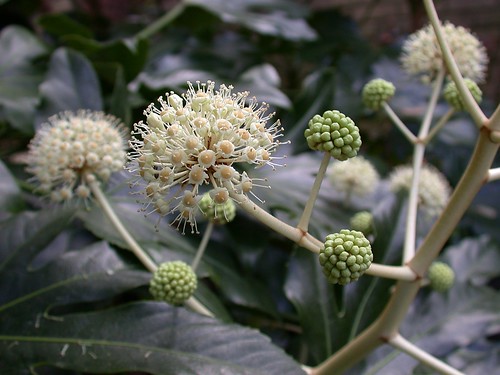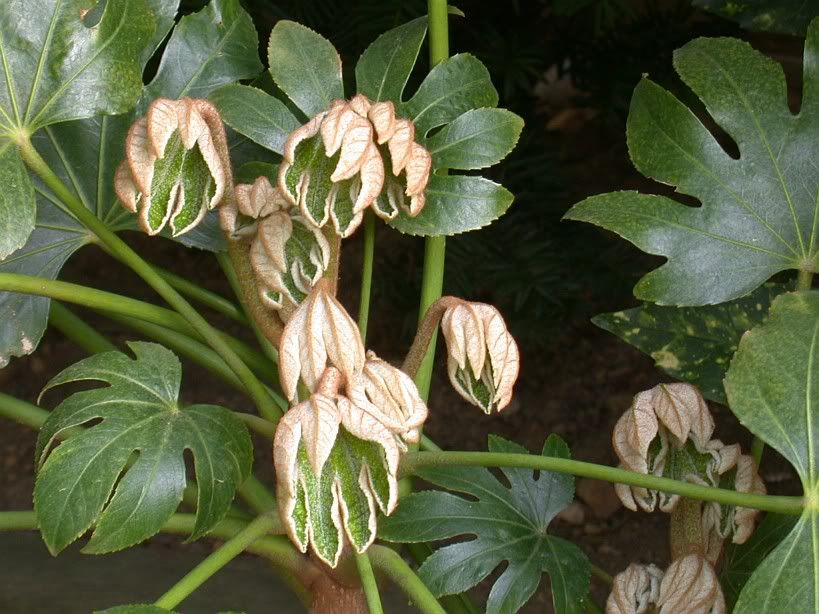Something spooky-looking emerges in my garden in the fall. Every October without fail, shortly before Halloween, fat buds begin to swell on my Fatsia japonica and from them emerge ghostly flower buds, tightly packed into little balls and looking more like some fungus that would emerge from the grave of a hastily-buried corpse in a science fiction movie. Only when they fully expand and the thousands of tiny buds open do they begin to resemble actual flowers, and even then it's more like the poor plant had an accident and exploded while it was trying to bloom.
Some of my gardening friends in zones 8 and 9 may pooh-pooh Fatsia because it isn't anything new, it isn't anything unusual, it isn't anything rare. Even in colder climates many people are already familiar with this species, but strictly as a houseplant. This is the kind of houseplant for people who don't really want houseplants, but would rather have something plastic that requires no care except for an occasional dusting. But put it outdoors, in the ground, and oh what a different thing it becomes! For one thing, it gets big. And it blooms. And it does the most amazing thing in winter, something you'll never see it do indoors. For those of us in zone 7, Fatsia japonica is a plant that is still uncommon enough to be interesting and even surprising.

Fatsia japonica at the United States National Arboretum
As the name suggests, Fatsia japonica comes from Japan. Fatsia is a very small Asian genus of shrubs in the aralia family (Araliaceae) with only two other species, with its closest relative being the North American genus Oplopanax with a single species, O. horridus. (Which really is most splendidly horrid. Look it up.) Fatsia is grown primarily for its bold, glossy, almost tropical-looking evergreen foliage but is surprisingly hardy. Although generally rated as hardy to zone 8, and marginal at best in zone 7, my plants have been in the ground for over 10 years and have survived single-digit temperatures without damage. During that time they have received no winter protection except for mulch.
Fatsia puts on an interesting show in the fall, blooming when almost nothing else does. My plants generally bloom from late October into December, with the flowers undamaged by temperatures down to the mid-20's. The primary pollinators of the tiny white flowers seem to be flies, although I've also seen honeybees on the flowers. The immature fruits remain on the plants over the winter and if it stays warm enough--generally above mid-teens--the fruits will swell and ripen in the spring, turning dark purple-black and looking like miniature blueberries. Although my plants have bloomed every fall for the past 9 years, during the first few years they never produced mature fruit. Thanks to warmer winters in recent years, my plants have produced mature fruits in 4 out of the last 6 years.

Fatsia japonica, blooming in early November

Mature inflorescence

Flowers

Ripe fruit
Propagation is by seed or by stem cuttings. I grew my own plants from three different seed sources; germination was very poor from dried seeds from two commercial sources, but fresh seed from a third source had excellent germination. Fresh seeds can be mashed out of the berries and barely covered with soil or potting mix; they do not require cold stratification or any other special treatment and will germinate quickly, usually within 2-3 weeks. The seedlings are best grown indoors for the first year and planted out in the spring of their second year to give them a full growing season to establish. The young growing tips are sensitive to freezing and protection during the first winter may be helpful, especially if temperatures fall below the teens. But once established they are practically bullet-proof. There may be some variation in hardiness depending on the source of the plant or seeds; although I haven't seen much difference between my own seed-grown plants, a small plant that I picked up in the houseplant section of a local nursery never made it through the first winter. Propagation is also very easy by stem cuttings. Sections of stem with 3-5 nodes and the leaves stripped off can be planted upright or horizontally, and will root and produce new growth fairly quickly.
I've found Fatsia japonica to be a very easy species to grow. As houseplants they seem to spontaneously generate spider mites, but outdoors I've found them completely pest-free. Fatsias grow best in rich, moist, well-drained soil but are quite drought-tolerant once established. They perform quite well in full shade, but can take some direct sun as long as they have adequate moisture. Personally, I find the open, loose habit of shade-grown plants more attractive than the dense, tight growth habit of plants grown in sun. The plants also tend to produce larger leaves in full shade. New foliage is produced in a single spring flush with the emerging leaves almost as creepy as the inflorescences, looking like contorted little hands, but as they expand they turn a translucent yellow-green and glow dramatically when backlit by the sun.

New foliage emerging in spring

Spring foliage
Mature leaves are tough, leathery, and deep green. Individual leaves last about a year; over the summer the previous year's leaves turn yellow, then brown, then black and finally fall, leaving bare lower stems. Fatsias can grow quite large, but tolerate hard pruning and are easily kept in check by selectively removing individual stems at the base. An established plant can even be pruned to the ground and will come back. Pruning is best done in early spring, to give new foliage enough time to harden before cold weather. Pruning later in the year encourages new growth that will be killed by freezing temperatures.
Speaking of freezing temperatures, Fatsia japonica has one more trick up its sleeve. Fatsias are hardy to at least the low single digits, but at temperatures more than a few degrees below freezing they collapse in the most dramatic way, turning limp and black and looking like boiled spinach. The first time I saw this happen, I thought for sure my plants were dead but to my surprise, they miraculously sprang back without any damage as soon as temperatures went back above freezing. I've dubbed this dramatic behavior "fatsia flop".

"Fatsia flop"
The species was originally described in 1784 as Aralia japonica by Swedish naturalist Carl Peter Thunberg and became known as "japanese aralia", a name still sometimes used for this plant. In 1854 the French botanists Joseph Decaisne and Jules Émile Planchon noted that it differed from the true aralias and named it Fatsia after the Japanese word "fatsi" (a variant of "hachi", or 8) for the same plant. The name apparently refers to the leaves frequently having 8 lobes but individual leaves on a single plant can have 7-9 lobes. However, the species is somewhat variable with regard to how many lobes the leaves have, and how deeply they are lobed. There are several variegated forms that I haven't tried, and are supposed to be somewhat less hardy. The best-known variegated form is the cultivar 'Spiderweb'.

Fatsia japonica 'Spiderweb', Norfolk Botanical Garden
Finally, there are a couple of other species in the genus that have promise as ornamental plants. Fatsia polycarpa has recently been introduced with Taiwan, but its hardiness is still incompletely tested. The leaves are more deeply lobed and less glossy than those of Fatsia japonica.

Fatsia polycarpa at Plant Delights Nursery in Raleigh, North Carolina
And yes, all you know-it-alls out there, there is × Fatshedera lizei, an intergeneric hybrid between Fatsia japonica and Hedera helix (english ivy, or if you really want to quibble maybe Hedera hibernica, I really haven't stayed on top of that taxonomic mess). Which somehow manages to combine the worst characteristics of both genera, and yet people still grow it. Go figure.
For more Fatsia photos, please visit my Flickr album.


very nice info and pictures about a plant that even in milder climates is both reliable and striking in almost all it's parts. a true "tropical" looking plant for the exotic garden. so glad it's available for use outdoors in both your zone 7 garden in D.C. and my (supposedly) 9b garden in bandon, Oregon. georgeinbandon,oregon
ReplyDeleteAre black leaves just ageing or can they be caused by pests? Dan Skibbereen Co. Cork,Ireland
ReplyDeleteI've had no trouble with pests outdoors (indoors is another story entirely!). Last year's leaves to start falling off in early summer and it's quite normal for them to turn yellow and then black. But if your plant is growing poorly or looks unhealthy otherwise, then I'm not sure.
Deletewould this be hardy in Baltimore?
ReplyDeleteDepending on precisely where, and how much shelter you can give it (especially from winter sun & wind) I suspect it should be hardy for several years at least. There's some luck involved as well, depending on just how cold the winter gets! My plants did take a hit from this past winter, but all are sending up strong new growth from the base.
Delete